 Open Access
Open Access
ARTICLE
Real-Time Identity Authentication Scheme Based on Dynamic Credentials for Power AIGC System
State Grid Gansu Electric Power Research Institute, Lanzhou, 730000, China
* Corresponding Author: Feng Wei. Email:
Computers, Materials & Continua 2025, 82(3), 5325-5341. https://doi.org/10.32604/cmc.2025.058802
Received 21 September 2024; Accepted 13 December 2024; Issue published 06 March 2025
Abstract
The integration of artificial intelligence (AI) with advanced power technologies is transforming energy system management, particularly through real-time data monitoring and intelligent decision-making driven by Artificial Intelligence Generated Content (AIGC). However, the openness of power system channels and the resource-constrained nature of power sensors have led to new challenges for the secure transmission of power data and decision instructions. Although traditional public key cryptographic primitives can offer high security, the substantial key management and computational overhead associated with these primitives make them unsuitable for power systems. To ensure the real-time and security of power data and command transmission, we propose a lightweight identity authentication scheme tailored for power AIGC systems. The scheme utilizes lightweight symmetric encryption algorithms, minimizing the resource overhead on power sensors. Additionally, it incorporates a dynamic credential update mechanism, which can realize the rotation and update of temporary credentials to ensure anonymity and security. We rigorously validate the security of the scheme using the Real-or-Random (ROR) model and AVISPA simulation, and the results show that our scheme can resist various active and passive attacks. Finally, performance comparisons and NS3 simulation results demonstrate that our proposed scheme offers enhanced security features with lower overhead, making it more suitable for power AIGC systems compared to existing solutions.Keywords
Smart grids are designed to improve the efficiency of energy distribution by using advanced sensors, communication technologies, and automated controls. However, the sheer volume and velocity of data generated by these systems pose significant challenges for traditional data processing, transmission methods, and data security [1]. The real-time transmission of Artificial Intelligence (AI)-generated data offers a solution by providing a representation of grid status and performance metrics. This approach not only facilitates faster decision-making but also enhances the ability of grid operators to monitor and respond to anomalies in real time. Of course, the secure transmission of real-time data is a prerequisite for ensuring the accuracy of decision-making. Therefore, in order to achieve secure real-time transmission of power monitoring data and Artificial Intelligence Generated Content (AIGC) data, implementing advanced encryption and authentication protocols is essential to prevent unauthorized access and ensure the integrity of the transmitted information [2].
In the era of digital transformation, the integration of AI with smart grid technologies has emerged as a powerful paradigm, revolutionizing the way we manage and optimize energy systems [3]. One of the most compelling advancements in this field is the real-time data transmission scheme for AIGC, which plays a crucial role in enhancing the efficiency and reliability of smart grids [4]. Particularly with the recent development of large language models, AIGC has become a key player in decision-making within the field of data analysis and processing. As energy grids become increasingly complex and interconnected, the need for rapid, accurate, and secure data exchange has never been more critical. This real-time data transmission scheme aims to address these challenges by leveraging AI-generated data to provide a more intuitive and dynamic view of grid operations, while also incorporating robust data security measures.
Furthermore, the integration of AI in the real-time data transmission process introduces a new level of sophistication and adaptability, along with the need for enhanced security. AI algorithms can analyze and interpret complex data streams, generating images that highlight critical information and trends [5]. This capability is particularly valuable in dynamic and evolving grid environments where traditional methods may fall short. For instance, AI-generated data can dynamically reflect changes in grid load, generation, and distribution, providing operators with actionable insights and predictive analytics that support proactive management and optimization. Ensuring that these AI-generated data are securely transmitted and stored requires the implementation of robust cybersecurity measures to protect against data breaches and tampering [6].
With the continuous development of smart grid technology, the integration of real-time data security transmission and AIGC will play a pivotal role in shaping the future of energy management. Ensuring the resilience and security of power AIGC systems has become a central focus of current research. Therefore, schemes based on public key cryptographic primitives have been widely proposed. While these schemes offer high security, their heavy key management and computational overhead make them unsuitable for resource-constrained Internet of Things (IoT) devices, such as smart meters. In contrast, authentication and Key agreement protocols and physical layer key generation schemes based on symmetric encryption primitives are also being optimized. These schemes rely on one-time session keys, negotiated in secret, to achieve efficient data transmission. However, due to the heterogeneity of devices and the presence of channel noise in smart grids, generating stable physical layer keys remains a challenge. Therefore, to ensure the secure integration of AIGC and power data, it is crucial to design an efficient and secure lightweight identity authentication and scheme specifically tailored for power AIGC systems.
Considering the security and performance requirements of smart grids, numerous schemes for real-time data collection and secure transmission have been proposed.
In 2015, Liu et al. [7] proposed a lightweight communication protocol for secure two-way communication in grids. The scheme employs bitwise Exclusive OR (XOR) for encryption and Lagrange interpolation for authentication, allowing for real time message verification. In 2017, Velusamy et al. [8] designed a probability-based trust calculation method to address security challenges in smart grid communication networks (SGCN), which are vulnerable to packet-dropping attacks. In 2018, Wu et al. [9] introduced an effective Identity-Based Encryption with Equality Test (IBEET) framework for smart grids, aiming to balance customer privacy with power system optimization. Their scheme utilizes bilinear pairing to eliminate the time-consuming HashToPoint function and restricts trapdoors to specific keywords, thereby preventing privacy leakage. In 2018, Nangrani et al. [10] designed a novel interleaved performance index for assessing the dynamic security of smart grid networks, addressing the unpredictable dynamics of power flow on transmission lines. Their approach combines the Lyapunov Exponent to quantify chaos with a conventional megawatt performance index for overload monitoring, resulting in the Interleaved Mega Watt-Lyapunov Exponent performance index. In 2019, Jolfaei et al. [11] addressed the vulnerability of phasor measurement units (PMUs) in smart grids. They proposed a streamlined and secure integrity protection algorithm that ensures the safety of PMU data, demonstrating resilience against ciphertext-only and known or chosen plaintext attacks. Their method outperforms existing solutions in terms of speed while meeting strict timing requirements, making it suitable for power protection applications and emerging anomaly detection scenarios involving rapid message exchanges. In 2020, Wang et al. [12] introduced a robust and efficient authentication protocol that integrates blockchain technology, Elliptic Curve Cryptography (ECC), and a dynamic Join-and-Exit protocol, and batch verification to enhance security for smart meters and utility management centers. In 2021, Tur et al. [13] proposed a design that enhances the reliability of the current grid model by incorporating chaotic codes into communication instructions. Their case study, which involves transmitting and encoding instructions four times daily, demonstrates that the proposed method achieves necessary reserve capacity and robust chaotic encryption. In 2022, Sasikum et al. [14] proposed an improved Delegated Proof of Stake (DPoS) consensus mechanism that facilitates real-time data transmission by enabling nodes to efficiently reach consensus for block generation and securely store information in trading nodes. In the same year, Kebotogetse et al. [15] designed a streamlined Concealed Based Security Scheme that enhances data transmission security through authentication while minimizing computational overhead and energy consumption. Compared to the advanced metering infrastructure (AMI) data communication framework, which does not incorporate authentication.
In addition, with the gradual maturity of AI technology, AI-based intelligent monitoring and security solutions for smart grids are developing rapidly. In 2018, Medved et al. [16] designed a novel demand response scheduling method using an approximate Q-learning (AQL) algorithm for aggregators to optimize the operation schedules of flexible active resources. Their simulations conducted on a practical low-voltage grid model show that, while the economic approach yields the highest profit but results in the highest number of schedule violations, and the energy allocation strategy improves the voltage profile, however, it leads to reduced profits, the AQL approach balances economic performance and minimal schedule violations, validating their hypothesis. In 2020, Hansan et al. [17] addressed the challenges of real-time communication and precise synchronization in smart grid applications, which are essential for accurate monitoring, measurement, and control. To tackle these challenges, they proposed an AI-based synchronization scheme using a backpropagation neural network for timing estimation and error correction. In 2021, Barja-Martinez et al. [18] revealed interdependencies between these services, suggesting they can be offered as bundled solutions to stakeholders. They highlight the growing application of deep learning for time series prediction, unsupervised learning techniques for customer segmentation and non-technical loss detection, and reinforcement learning for energy management systems. In 2022, Wang et al. [19] proposed a novel approach using hyperdimensional computing (HDC) to detect anomalies in real-time directly from raw meter data, eliminating the need for extensive pre-processing. The method employs an associative memory for classifying hypervectors, which enhances robustness to data imbalance and includes a retraining mechanism to enhance accuracy further. In the same year, Khan et al. [20] reviewed the role of AI and machine learning in Demand Response (DR), highlighting their effectiveness in optimizing user engagement and managing complex tasks. They discuss various AI approaches and commercial applications for DR in different countries, along with the integration of blockchain technology. To address the real-time secure communication requirements between aggregators (AGs) and smart meters (SMs) in smart grids, in 2023, Wang et al. [21] proposed an efficient and provably secure identity authentication and key agreement scheme based on extended Chebyshev chaotic mapping. This scheme preserves the anonymity of smart meters and achieves perfect forward security, effectively resisting common threats such as replay attacks and identity forgery. In the same year, Ayub et al. [22] proposed a privacy-preserving identity authentication protocol for smart grid consumer centers that leverages blockchain authentication to enhance resistance to potential attacks and ensure the real-time integrity of response data. Additionally, they incorporated Physically Unclonable Functions (PUFs) to guard against physical attacks. In 2024, Benrebbouh et al. [23] proposed a security-enhanced identity authentication protocol leveraging blockchain technology. This protocol builds on the existing smart grid authentication architecture, integrating blockchain’s security mechanisms to ensure secure communication among various IoT devices.
This section defines the data transmission model and threat model for the real-time data transmission scheme of AIGC in smart grid, and elaborates on the functions of the participating entities and the capabilities of adversaries.
3.1 The Power AIGC System Model
The smart grid system model primarily includes three types of entities: data consumers, intelligent gateway nodes (GWN), and data generation devices. As shown in Fig. 1, the smart grid includes power generation, transmission, transformation, distribution, and consumption, with secure data transmission accompanying the entire power flow. In addition, AI technology has gradually become the core support for smart grid data decision-making and analysis, as exemplified by AIGC in the Fig. 1.

Figure 1: The architecture of power AIGC system
The data generation device is responsible for collecting and providing real-time data, including but not limited to grid data and monitoring images. The intelligent gateway functions as both an identity authentication intermediary and a data intermediary between generation devices and consumers, the data consumers can access grid data in real time through the intelligent gateway. Providing secure real-time data transmission in the power system is difficult due to the resource limitations of generation devices and the vulnerability of deployed devices [24]. Moreover, refer to the work of [25–27], the communication energy of power generation device is usually positively correlated with the communication distance between entities. Therefore, we choose the intelligent gateway to serve as the intermediary to balance the security of communication and the energy consumption.
This section adopts the attack capabilities defined by the Dolev-Yao (DY) model as the threat model for security analysis. Consequently, we assume that an adversary in the smart power data transmission system possesses the following basic capabilities:
• The adversary can intercept, modify, delete, and replay data transmitted through the public channel.
• An adversary may employ side-channel attacks to extract secret parameters stored within consumer devices. Similarly, grid terminals may also be compromised, allowing attackers to access and retrieve secret parameters.
• The adversary may include a legitimate user who acts maliciously. However, the adversary cannot access the AIGC model parameters or training data.
This section proposes a secure identity authentication and key agreement scheme for power AIGC system, the specific authentication steps and update steps are shown in Fig. 2. The scheme facilitates both identity authentication and the generation of one-time symmetric keys, ensuring the integrity and efficiency of data transmission within the smart power system. Additionally, it is important to note that existing schemes typically require synchronization of the clocks of consumers, intelligent gateways, and data generation devices. To address this, we incorporate a system timestamp into the scheme to mitigate replay attacks.

Figure 2: The steps of our proposed protocol
Before deploying, the System Administrator (SA) must initialize the data consumer, intelligent gateway, and data generation device in offline mode.
Step1: The SA assigns
Step2: The SA generates random numbers {MK} as the authentication master key.
Step3: The intelligent gateway stores the master key {MK} in its database, and retains all the
4.2 Data Consumer Registration Phase
During the execution of this registration phase, the data consumer
Step1: At first,
Step2:
Step3: After receiving
4.3 Data Generation Device Registration Phase
Similarly, this phase is also conducted through a offline and secure channels. The registration phases are described below:
Step1: The data generation device gets identity
Step2: Upon receiving
Step3: Finally, the gateway stores
After the legal data consumer
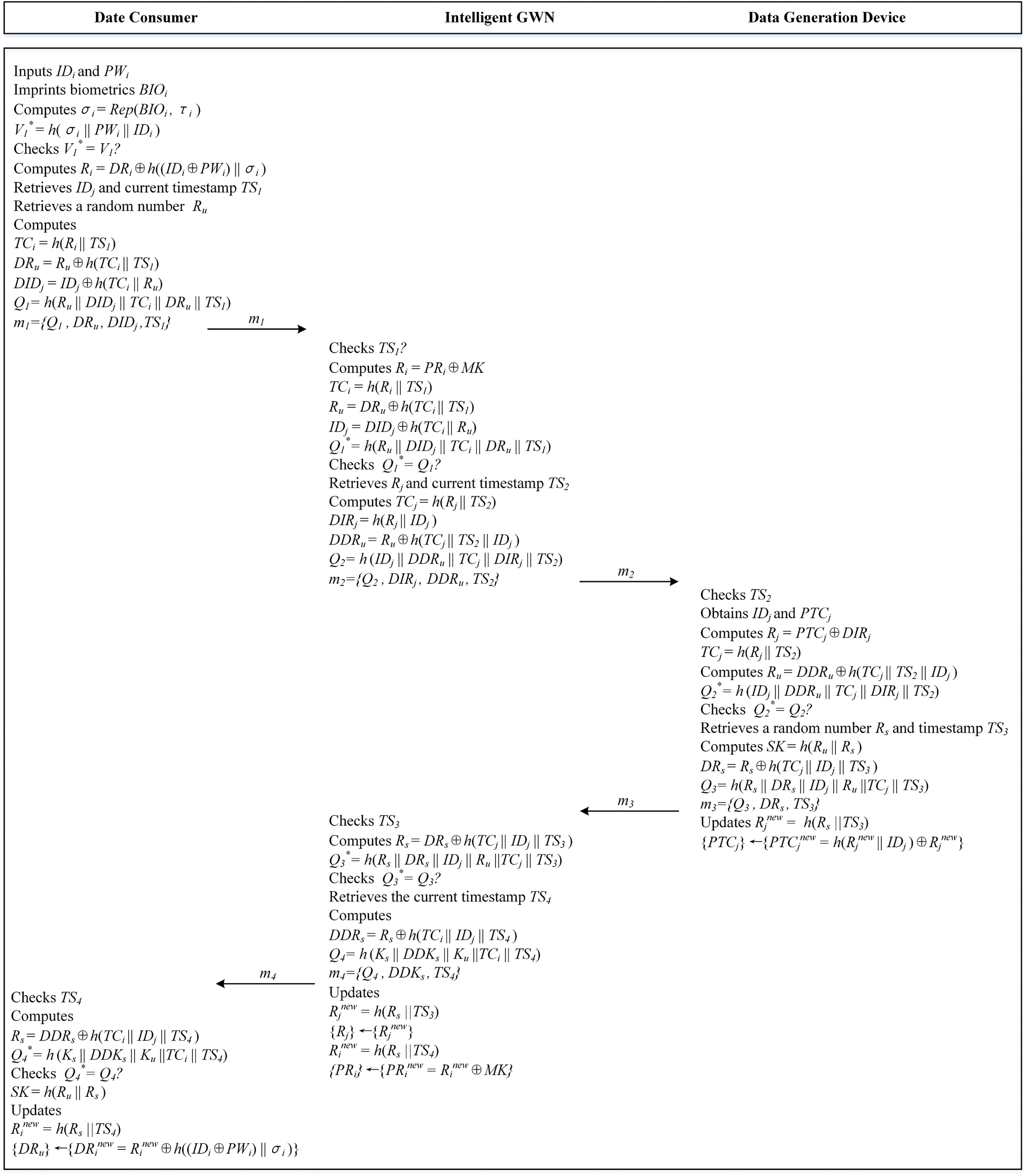
Figure 3: Login, authentication and key agreement, dynamic credential update phases
Step1:
Step2:
4.5 Authentication and Key Agreement Phase
The entities in our scheme complete mutual authentication, allowing the data consumer and the device generates a session key SK for secure encrypted communication. This process is depicted in Fig. 3.
Step1:
Step2:
Step3: Upon receiving
Step4: The intelligent gateway checks
Step5: The intelligent gateway sends
Step6: Upon receiving
Step7: The device sends
Step8: Upon receiving
Step9: The gateway sends
Step10: Upon receiving
4.6 Dynamic Credential Update Phase
After the SK negotiation is completed, the credentials are dynamically updated. The details of the credential update phases are shown in Fig. 3.
Step1: The gateway computes
Step2: The device computes
The legitimate
Step1:
Step2:
The security of data transmission relies on the security of encryption keys. Therefore, we use the widely accepted ROR model to illustrate the security of SK in this scheme and provide the following primitives related to the ROR model. We set the semantic security of our scheme as follows.
Semantic security. We define the advantages of an adversary successfully attacking the scheme to compute the session key as
The proof of our scheme is as follows:
Theorem 1. Suppose the adversary
•
•
•
• |D|: The size of the password dictionary.
•
Based on these definitions, the advantage in compromising the session key SK can be estimated as
Proof. To prove
After
According to (2), (3) and (6), we can obtain the following relation:
Similarly, according to (4), (5), (7) and the triangular inequality, we can obtain the following relation:
Finally, multiply the two sides of (8) by factoring
AVISPA utilizes a formal simulation language known as HLPSL to precisely define protocol behaviors, data structures, cryptographic elements, and the abilities of attackers. It offers four verification backends, with OFMC and CL-AtSe being the most commonly applied in protocol certification research. These two models are particularly useful for verifying whether SK is securely negotiated and determining if the scheme can resist both passive and active attacks. The outcomes from these models are presented in Fig. 4, demonstrating that the scheme is secure and effectively defends against various common attacks.
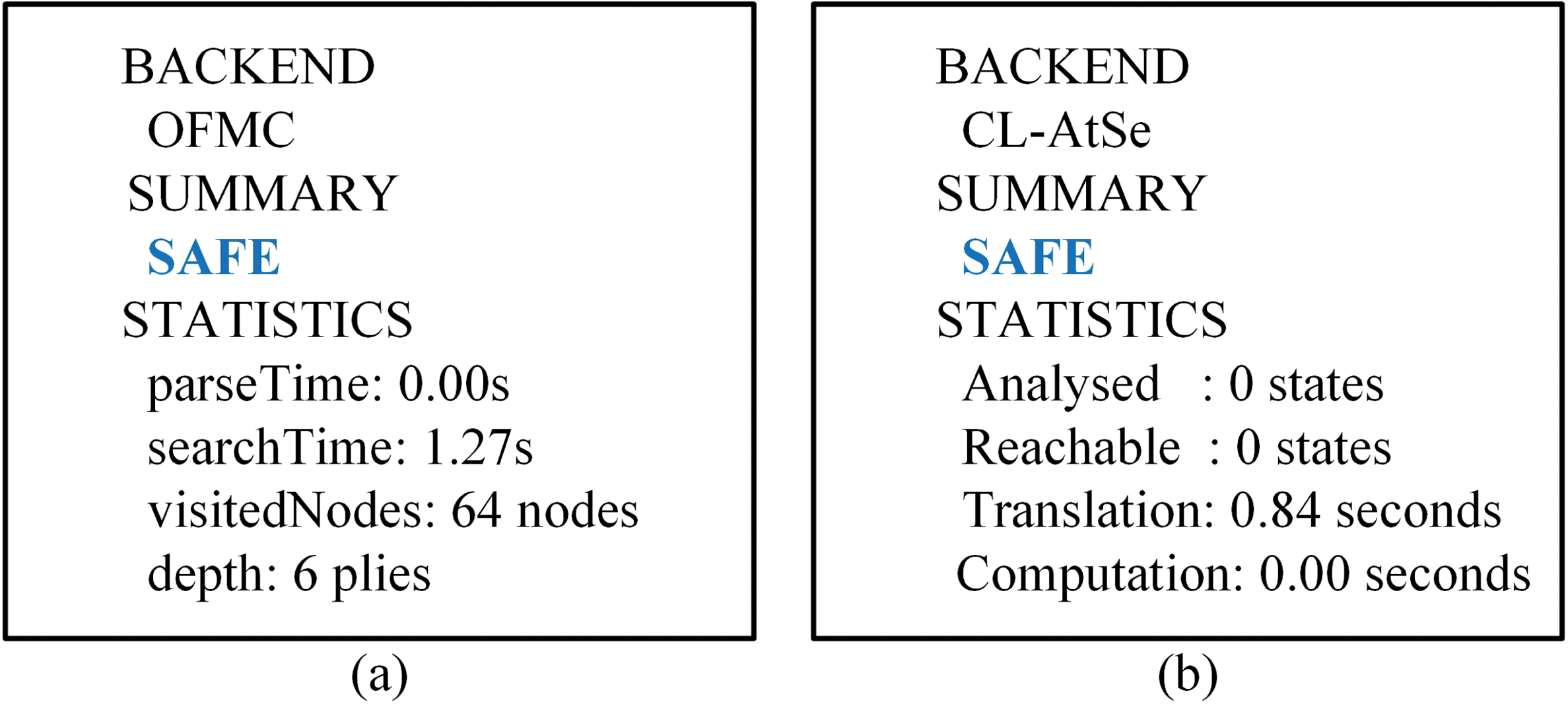
Figure 4: (a) OFMC (b) CL-AtSe
5.2 Informal Security Analysis
In this section, we examine the security of the proposed scheme and compare it with other related approaches [25–27]. The detailed analysis is presented below.
A replay attack occurs when an adversary retransmits previously intercepted packets to the same target entity with the intention of deceiving it. Consequently, we suppose that an adversary can intercept messages and attempt to launch replay attacks against the entities. However, all entities verify
5.2.2 Man-in-the-Middle Attack
Similarly, an adversary might intercept information
An online guessing attack involves an attacker attempting to crack target information by repeatedly trying different parameter combinations. An adversary might attempt to launch online guessing attacks as follows:
• The adversary can obtain
• To obtain
Thus, the adversary cannot successfully extract information through online guessing attacks against the proposed scheme in this paper.
Offline guessing attacks are typically combined with device loss attacks. After gaining access to storage information, the attacker attempts to obtain core parameters by making repeated guesses. First, while the adversary can access the information stored on the device, they cannot directly obtain sensitive information such as
A tracking attack occurs when an adversary analyzes parameter information intercepted through a public channel and uses identity identifiers and fixed constants to track the sending entity. According to our analysis of online guessing attacks, we observe that messages are dynamic in each authentication process due to the inclusion of random values and timestamps. Because of these dynamic parameters, the adversary cannot reliably track entities in the network. Therefore, the scheme presented in this paper is resistant to tracking attacks.
A Distributed Denial of Service attack takes place when an attacker exploits a network of compromised computers transmit a substantial quantity of requests to a target in a short time frame. This overwhelming traffic drains the target’s computational resources or network capacity, preventing it from delivering normal services. In extreme scenarios, the target system may crash or stop functioning altogether. We assume that the adversary has the ability to intercept messages and initiate DDoS attacks against the device. Upon receiving a simulation request, the device first confirms the validity of the timestamp’s freshness. If the timestamp fails to meet the synchronized clock’s threshold, the request is automatically rejected. As a result, the presented scheme is capable of mitigating such attacks effectively.
Each communicating entity retrieves a random number during every authentication, and these random numbers are used to compute the session key (SK). Consequently, the SK changes dynamically and randomly throughout the mutual authentication process. Additionally, when the device joins or leaves the smart grid system, no entity can access the previous or subsequent SK. Therefore, the scheme proposed in this paper effectively meets the forward security requirements.
This section provides a comparison between the security and functionality of the presented scheme and related works [25–27]. A detailed comparison is outlined in Table 1.
This section assesses the computation, communication, and storage overheads associated with the proposed framework for intelligent endpoints. Additionally, we compare these aspects with those of advanced, relevant schemes [25–27] in the same field. The details of the comparison are described below.
This section assumes that the running time of our scheme is equal to that of an Intel Xeon CPU (2.60 GHz, 8 GB RAM) [27]. Additionally, the following parameters are assumed: a 32-bit timestamp; identity, secret number, and random number each of 160 bits; a hash function output of 160 bits; and an ECC point multiplication output of 320 bits. Furthermore, the ciphertext length following symmetric encryption is assumed to match the total size of the plaintext. The execution times for these computations are summarized in Table 2.

This section compares the computation overheads of [25–27]. Table 3 shows the computation overheads of our scheme and [25–27]. It is not difficult to find that our computational cost is better than [25,27].
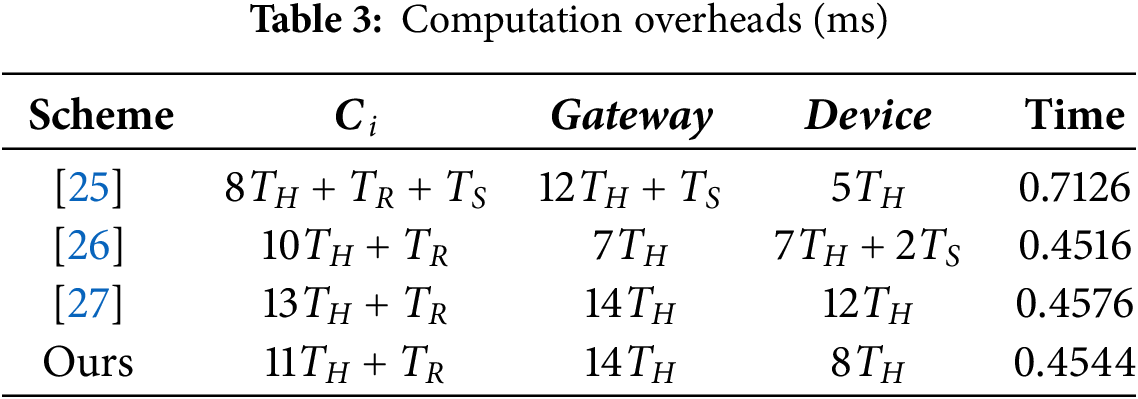
This section compares the communication overheads of our scheme with those reported in [25–27]. As illustrated in Table 4, our scheme exhibits lower communication overhead compared to the other schemes.
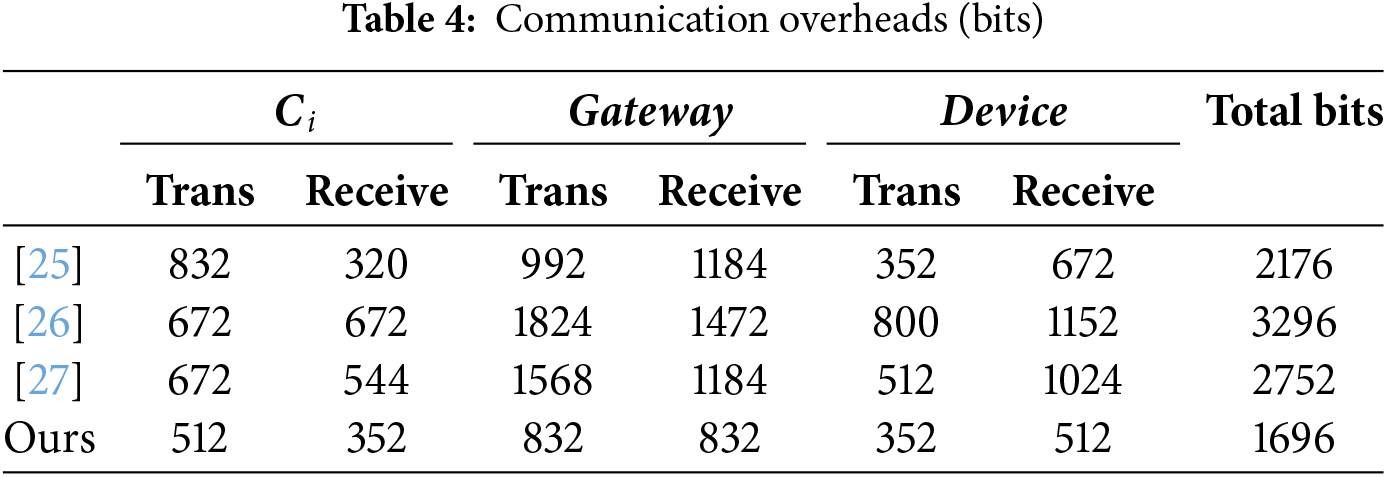
Referencing the analysis above, this section compares the storage overheads of our scheme with those in [25–27]. Table 5 demonstrates that our scheme requires less storage overhead than the other schemes. Furthermore, it offers superior security and additional functional features, as outlined in Table 3.
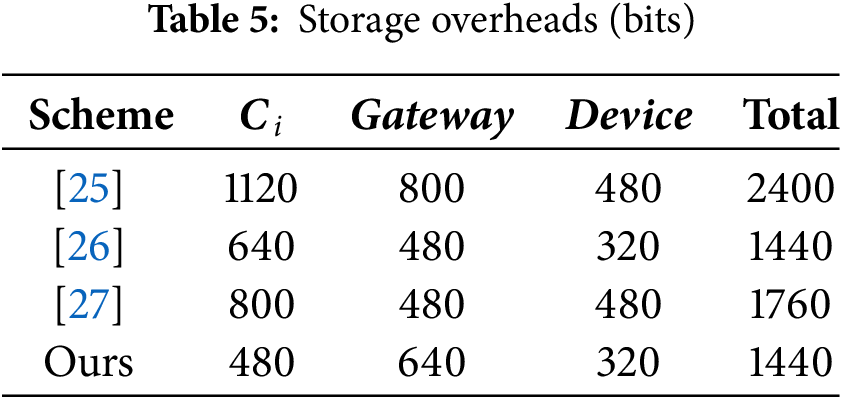
In this section, we use the NS3 simulation tool [28] to simulate our scheme alongside [25–27]. We analyze the impact of end-to-end delay and network throughput, two critical network performance parameters. The simulation experiments are conducted on the Ubuntu 16.04.7. In the simulation setup, users are distributed within a square area centered around an gateway, allowing for free movement. The devices are distributed along a circular radial. Additionally, the simulation time is 1600 s and all entities communicate using the 2.4 GHz IEEE 802.11a Wi-Fi standard. The simulation details are provided in Table 6.
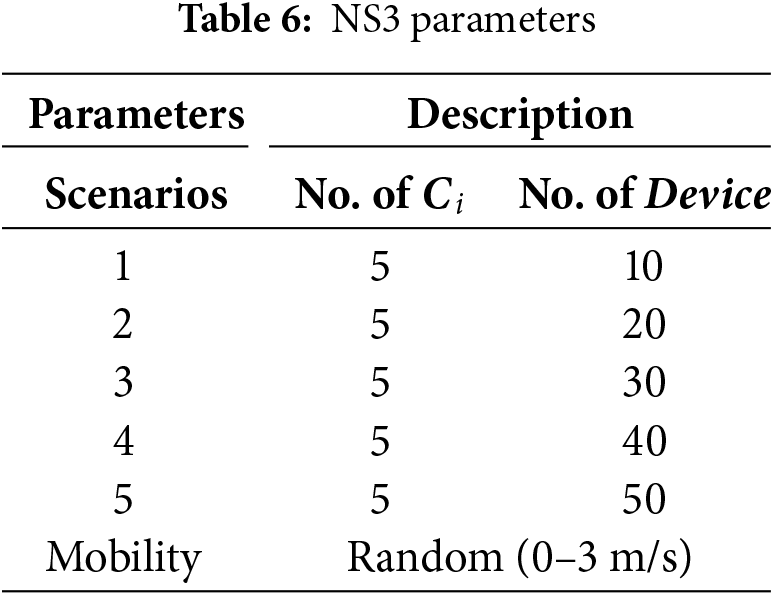
6.5.1 End-to-End Delay Analysis
End-to-end delay is a critical metric for assessing network real-time performance. It is calculated as the average time required for a message to travel from the sender to the receiver. The simulation results for end-to-end delay are shown in Fig. 5. It is evident that the end-to-end delay of our proposed scheme is lower compared to the schemes in [25–27], primarily due to our design, which incorporates smaller message sizes during the authentication phase.
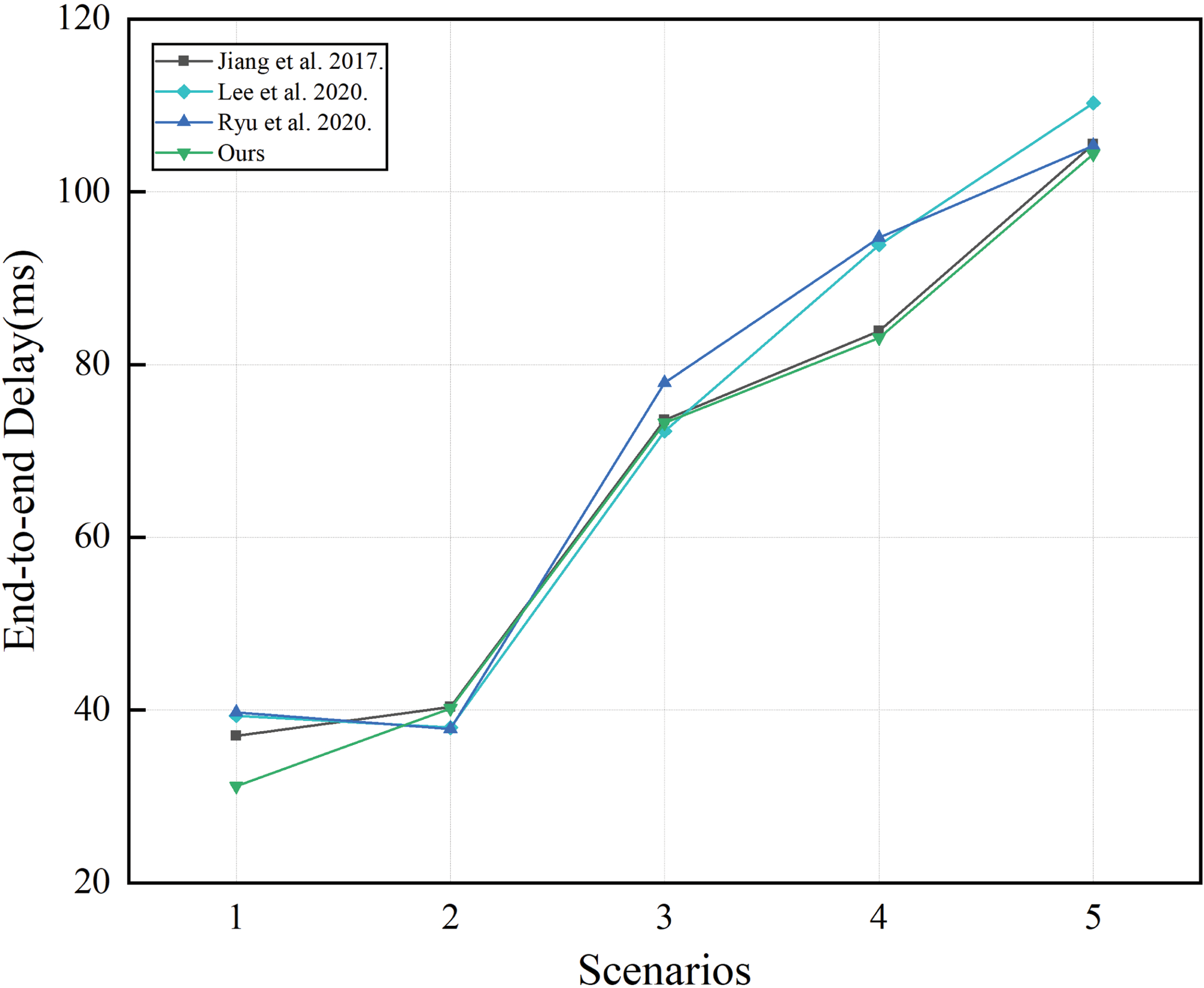
Figure 5: Comparison of end-to-end delay with related works [25–27]
Network throughput refers to the number of bits transmitted per unit of time. Fig. 6 shows that the throughput of the proposed scheme is lower than that of the schemes presented in [25–27]. This lower throughput is attributed to our scheme’s use of smaller messages during the authentication process. Moreover, it is important to note that our scheme offers additional functionality features and improved security compared to the related schemes.
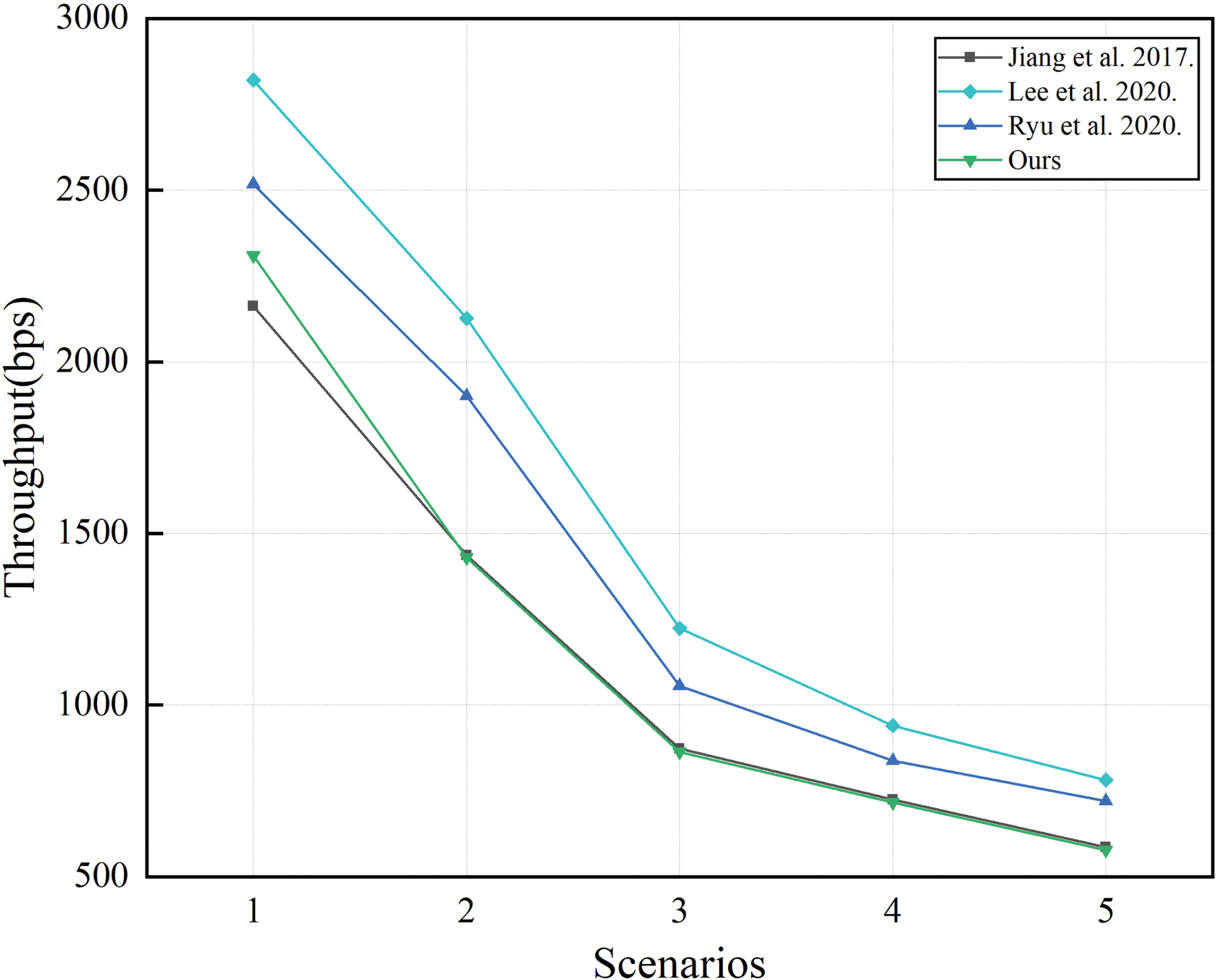
Figure 6: Comparison of network throughput with related works [25–27]
In this paper, we proposed a real-time identity authentication scheme based on dynamic credentials for power AIGC systems. The scheme includes a dynamic credential update phase that facilitates the continuous change of session keys, thereby enhancing the availability and security of the power AIGC system. We compare the security and performance of our scheme with several related authentication schemes, with the results indicating that our scheme offers superior security with minimal performance overhead. Finally, we employ the NS3 simulator to assess the network performance of our proposed scheme in comparison to other existing schemes. The simulation results indicate that our scheme is particularly well-suited for integration within power AIGC system.
Acknowledgement: The authors are very grateful to the anonymous reviewers for their detailed comments and suggestions.
Funding Statement: Not applicable.
Author Contributions: The authors confirm contribution to the paper as follows: study conception and design: Feng Wei, Zhao Chen; data collection: Yin Wang; analysis and interpretation of results: Dongqing Liu, Xun Zhang; draft manuscript preparation: Feng Wei, Zhao Chen, Zhao Zhou. All authors reviewed the results and approved the final version of the manuscript.
Availability of Data and Materials: The datasets generated and/or analyzed during the current study are not publicly available due to personal privacy reasons but are available from the corresponding author on reasonable request.
Ethics Approval: Not applicable.
Conflicts of Interest: The authors declare no conflicts of interest to report regarding the present study.
References
1. Chong ATY, Mahmoud MA, Lim F-C, Kasim H. A review of smart grid technology, components, and implementation. In: 2020 8th International Conference on Information Technology and Multimedia (ICIMU); 2020; IEEE. p. 166–9. [Google Scholar]
2. Moreno Escobar JJ, Morales Matamoros O, Tejeida Padilla R, Lina Reyes I, Quintana Espinosa H. A comprehensive review on smart grids: challenges and opportunities. Sensors. 2021;21(21):6978. doi:10.3390/s21216978. [Google Scholar] [PubMed] [CrossRef]
3. Alsafran AS, Hassan A, Abusada F, Alaraj MM. Challenges and solutions for AI explainability in smart grid literature review. SSRN Electron J. 2024. doi:10.2139/ssrn.4807531. [Google Scholar] [CrossRef]
4. Ayesha MNuman, Alhussein M, Baig MF, Aurangzeb K. Enhancing grid flexibility with coordinated battery storage and smart transmission technologies. J Energy Storage. 2024;100:113607. doi:10.1016/j.est.2024.113607. [Google Scholar] [CrossRef]
5. Yan Y, Hu RQ, Das SK, Sharif H, Qian Y. An efficient security protocol for advanced metering infrastructure in smart grid. IEEE Netw. 2013;27(4):64–71. doi:10.1109/MNET.2013.6574667. [Google Scholar] [CrossRef]
6. Shi Z, Yao W, Li Z, Zeng L, Zhao Y, Zhang R, et al. Artificial intelligence techniques for stability analysis and control in smart grids: method- ologies, applications, challenges and future directions. Appl Energy. 2020;278:115733. doi:10.1016/j.apenergy.2020.115733. [Google Scholar] [CrossRef]
7. Liu Y, Cheng C, Gu T, Jiang T, Li X. A lightweight authenticated communication scheme for smart grid. IEEE Sens J. 2015;16(3):836–42. doi:10.1109/JSEN.2015.2489258. [Google Scholar] [CrossRef]
8. Velusamy D, Pugalendhi G. An effective trust based defense mechanism to thwart malicious attack in smart grid communication network. In: 2017 IEEE International Conference on Intelligent Techniques in Control, Optimization and Signal Processing (INCOS); 2017; IEEE. p. 1–9. [Google Scholar]
9. Wu L, Zhang Y, Choo K-KR, He D. Efficient identity-based encryption scheme with equality test in smart city. IEEE Trans Sustain Comput. 2017;3(1):44–55. doi:10.1109/TSUSC.2017.2734110. [Google Scholar] [CrossRef]
10. Nangrani S, Bhat S. Smart grid security assessment using intelligent technique based on novel chaotic performance index. J Intell Fuzzy Syst. 2018;34(3):1301–10. doi:10.3233/JIFS-169426. [Google Scholar] [CrossRef]
11. Jolfaei A, Kant K. A lightweight integrity protection scheme for low latency smart grid applications. Comput Secur. 2019;86(1):471–83. doi:10.1016/j.cose.2018.09.014. [Google Scholar] [CrossRef]
12. Wang W, Huang H, Zhang L, Su C. Secure and efficient mutual authentication protocol for smart grid under blockchain. Peer-to-Peer Netw Appl. 2021;14(5):2681–93. doi:10.1007/s12083-020-01020-2. [Google Scholar] [CrossRef]
13. Tur MR, Ogras H. Transmission of frequency balance instructions and secure data sharing based on chaos encryption in smart grid-based energy systems applications. IEEE Access. 2021;9:27323–32. doi:10.1109/ACCESS.2021.3058106. [Google Scholar] [CrossRef]
14. Sasikumar A, Ravi L, Kotecha K, Saini JR, Varadarajan V, Subramaniyaswamy V. Sustainable smart industry: a secure and energy efficient consensus mechanism for artificial intelligence enabled industrial internet of things. Comput Intell Neurosci. 2022;2022(1):1–12. doi:10.1155/2022/1419360. [Google Scholar] [PubMed] [CrossRef]
15. Kebotogetse O, Samikannu R, Yahya A. A concealed based approach for secure transmission in advanced metering infrastructure. IEEE Access. 2022;10(4):84809–17. doi:10.1109/ACCESS.2022.3195240. [Google Scholar] [CrossRef]
16. Medved T, Artač G, Gubina AF. The use of intelligent aggregator agents for advanced control of demand response. WIREs Energ Environ. 2018;7(3):e287. doi:10.1002/wene.287. [Google Scholar] [CrossRef]
17. Hasan MK, Ahmed MM, Hashim AHA, Razzaque A, Islam S, Pandey B. A novel artificial intelligence based timing synchronization scheme for smart grid applications. Wirel Pers Commun. 2020;114(2):1067–84. doi:10.1007/s11277-020-07408-w. [Google Scholar] [CrossRef]
18. Barja-Martinez S, Aragüés-Peñalba M, Munné-Collado Í, Lloret-Gallego P, Bullich-Massagué E, Villafafila-Robles R. Artificial intelligence techniques for enabling big data services in distribution networks: a review. Renew Sustain Energ Rev. 2021;150:111459. doi:10.1016/j.rser.2021.111459. [Google Scholar] [CrossRef]
19. Wang X, Flores R, Brouwer J, Papaefthymiou M. Real-time detection of electrical load anomalies through hyperdimensional computing. Energy. 2022;261:125042. doi:10.1016/j.energy.2022.125042. [Google Scholar] [CrossRef]
20. Khan MA, Saleh AM, Waseem M, Sajjad IA. Artificial intelligence enabled demand response: prospects and challenges in smart grid environment. IEEE Access. 2022;11(1):1477–505. doi:10.1109/ACCESS.2022.3231444. [Google Scholar] [CrossRef]
21. Wang C, Li X, Ma M, Zhou T, Xu G, Xiong N, et al. PSAK: a provably secure authenticated key agreement scheme based on extended chebyshev chaotic maps for smart grid environments. Trans Emerg Telecomm Technol. 2023;34(5):1900. doi:10.1002/ett.4752. [Google Scholar] [CrossRef]
22. Ayub MF, Li X, Mahmood K, Shamshad S, Saleem MA, Omar M. Secure consumer- centric demand response management in resilient smart grid as Industry 5.0 application with blockchain-based authentication. IEEE Trans Consum Electron. 2024;70(1):1370–9. doi:10.1109/TCE.2023.3320974. [Google Scholar] [CrossRef]
23. Benrebbouh C, Mansouri H, Cherbal S, Pathan A-SK. Enhanced secure and efficient mutual authentication protocol in iot-based energy internet using blockchain. Peer-to-Peer Netw Appl. 2024;17(1):68–88. doi:10.1007/s12083-023-01580-z. [Google Scholar] [CrossRef]
24. Guo F, Herrera L, Murawski R, Inoa E, Wang C-L, Beauchamp P, et al. Comprehensive real-time simulation of the smart grid. IEEE Trans Ind Appl. 2013;49(2):899–908. doi:10.1109/TIA.2013.2240642. [Google Scholar] [CrossRef]
25. Jiang Q, Zeadally S, Ma J, He D. Lightweight three-factor authentication and key agreement protocol for internet-integrated wireless sensor networks. IEEE Access. 2017;5:3376–92. doi:10.1109/ACCESS.2017.2673239. [Google Scholar] [CrossRef]
26. Lee H, Kang D, Ryu J, Won D, Kim H, Lee Y. A three-factor anonymous user authentication scheme for internet of things environments. J Inf Secur Appl. 2020;52:102494. doi:10.1016/j.jisa.2020.102494. [Google Scholar] [CrossRef]
27. Ryu J, Kang D, Lee H, Kim H, Won D. A secure and lightweight three-factor-based authentication scheme for smart healthcare systems. Sensors. 2020;20(24):7136. doi:10.3390/s20247136. [Google Scholar] [PubMed] [CrossRef]
28. Amare T, Adrah CM, Helvik BE. A method for performability study on wide area communication architectures for smart grid. In: 2019 7th International Conference on Smart Grid (icSmartGrid); 2019; IEEE. p. 64–73. [Google Scholar]
Cite This Article
 Copyright © 2025 The Author(s). Published by Tech Science Press.
Copyright © 2025 The Author(s). Published by Tech Science Press.This work is licensed under a Creative Commons Attribution 4.0 International License , which permits unrestricted use, distribution, and reproduction in any medium, provided the original work is properly cited.


 Submit a Paper
Submit a Paper Propose a Special lssue
Propose a Special lssue View Full Text
View Full Text Download PDF
Download PDF
 Downloads
Downloads
 Citation Tools
Citation Tools